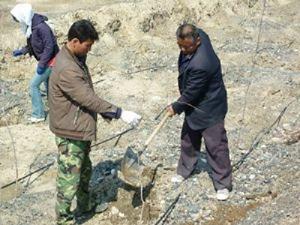Gang Chen
Other projects
3 Aug 2007
The Development of Sustainable Desert Communities and the Conservation of Wild Bactrian Camels in Xinjiang, China
27 Feb 2009
Promoting the Desert Communities Sustainable Development Methods for Better Wild Bactrian Camels Conservation in Xinjiang, China (Phase I)
The project aims to promote the sustainable desert communities development methods within the remaining families along the Lopnur nature reserve border for better conservation of wild Bactrian camels.

A wild bactrian camel running in the heartland of the Lopnur in April 2011.
The primitive ways of using wild plants as fuel and the overgrazing on the deserted land in local desert communities has been worsening the ecological environment in Ruoqiang county and endangered the survival and reproduction of the critically endangered wild Bactrian camels in adjacent Lopnur Reserve in Xinjiang, China.

Local volunteers planted branchy tamarisk seedling in the nursery in Aug 2010.
In order to solve the contradictions between conserving the wild Bactrian camels and developing sustainable desert communities in Ruoqiang county, I led my team to taught and supported local communities to use household methane system and the artificial planting technology of branchy tamarisks and desert-living cistanches to realize the conservation of wild plants and to prevent further desertification and to increase income for local desert communities. The achievement of previous project work in 995 local families funded by my 1st RSG and 2nd RSG had proved the success of these promoted technologies.
I am eager to continue my project work by promoting our successful project experience and model through further expanded and strengthened conservation programs and material supports to remaining about 2610 desert families within a greater geographical scope around Lopnur wild Bactrian camel reserve in Luoqiang county and realize the more widespread conservation of wild Bactrian camels, the sustainable development of local communities.
A nursery will be established to breed artificially branchy tamarisk seedlings and cistanche seeds to supply the remaining desert families around the Lopnur wild Bactrian camel reserve.
Training workshops will be held to train local conservationists to grasp the breeding technologies for the nursery so that they can run the nursery successfully later after the leave of my team members.
Through educational campaigns including presentations, conservational brochures distribution and on-site demonstrations, the remaining local desert communities consisting including about 8350 adults around the Lopnur reserve will be taught to grasp our artificial planting technologies and methane application technology for their welfare improvement and the conservation of wild Bactrian camels.
Seedlings of branchy tamarisks and seeds of desert-living cistanches supplied through the newly established nursery will be planted on more abandoned desert land around the Lopnur reserve by these families to generate sustainable income sources and strengthen conserving wild Bactrian camels.
An extensive monitoring of wild Bactrian camels inside the whole Lopnur reserve will be conducted to assess the effects on the conservation work on the population of wild Bactrian camels and allow us to know whether the quantity of the wild Bactrian camels will be stable or increased.